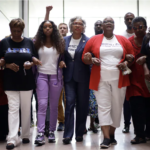| By the Chinese Historical Society of Southern California
In the 19th century, the first Chinese American financial handlers had the task of sending remittances back to Toisan, Sam Yup, Sze Yup, and other parts of Guangdong. An important goal of hardworking pioneers was to send money home to help their beloved families. Many of the gold miners in the Sacramento region, the contract laborers on the railroads, and the vegetable farmers in Southern California came to believe that their money was not always safe with mainstream money handlers. As Chinese Americans were not protected by the law, they needed to rely on alternative methods to achieve the same goals. Chinese family associations (huis) and district associations became the source of remittances and small loans. Businessmen traveling back and forth became remittance couriers. The tongs had their own economic systems as well. Early pioneers often pooled the economic resources of sometimes ten or fifteen partners to open a small store or laundry. Most immigrants worked completely in a cash economy and carried money bags on their bodies.
The Beginnings: 1960-70sKellogg Chan, retired Chairman and President of East-West Federal Bank, shares important history, “In 1937, there was only one Chinese bank on the West Coast, the Bank of Canton, operated by the Republic of China as a government bank in San Francisco. It was to remain that way for almost another twenty-five years. San Francisco’s Chinatown had six financial institutions such as Bank of America and Wells Fargo Bank. But financial pioneers such as Paul H. Louie of San Francisco, F. Chow Chan of Los Angeles, and Robert Chinn of Seattle already were making a strong bid to open Chinese American banks or thrift institutions in their own communities. Their efforts to obtain charters were turned down over and again. But eventually, their determined persistence would pay off.” By the 1950s and 1960s, the Chinatown community’s financial needs were not being met. “We were at the mercy of Bank of America and Security Pacific,” said Kellogg Chan. “It was very difficult for Chinese Americans to get loans; home ownership was a luxury.” Businesses like the bakeries, restaurants, and markets had banking needs. Chinese Americans wanted to invest in homes as they slowly moved out to Silver Lake, Lincoln Heights, and Monterey Park.
“There was no place to bank on a personal level or for a business,“ said CHSSC’s President, Ken Chan. “My father, F. Chow Chan, of Phoenix Bakery, had to go downtown all the time to do his banking. The terms were difficult; there was a lot of discrimination against people of color.” CHSSC Board Member Irvin Lai remembers, “I started my business in 1958. I had my license to repair refrigerators and air conditioners. I had $500 and bought a pick-up truck with some equipment. Other Chinese small businesses had to depend on friends or family associations to lend them some funds. I didn’t even have a family association in Los Angeles. There was hardly any financing available. I rented a place for $50 per month. I had to make that $500 stretch for six months. “I wanted to borrow a couple of thousand dollars to buy more equipment. I was stuck as a one-man outfit. I paid my rent, paid my taxes, and fed my family.” Irvin pounded the pavement for loans with no success. He finally got help from Cathay Bank, the first Chinese American bank in Los Angeles. F. Chow Chan and others tried for about a decade to apply for a bank charter. The application to begin a savings and loan institution was turned down two or three times by state regulators. Finally, advisor Preston Martin suggested that the group apply for a commercial bank charter instead and Cathay Bank was born. It opened its doors in Chinatown in 1962.
By the 1970s, other financial ventures began. Jack Lee said, “During the 1970s, there was a tremendous surge in the influx of Chinese immigrants to the United States. However, obtaining a home loan was no simple task for these new arrivals. The community was not only under-served by mainstream financial institutions, but many newcomers were also unaccustomed to the banking practices of their newly adopted home and did not know how to go about applying for a loan. As the Chinese American population grew larger, I believed that access to capital and credit would be critical if our community was to continue to thrive and prosper.” Kellogg Chan, one of the original founders of East-West Bank, explains the political background: “A key ally was acquired when Preston Martin of California was named to the vital post of Chairman of the Federal Home Loan Bank under President Nixon. A former USC law professor, Martin’s Minority Bank Outreach Program began a conscious effort to aid Asians, Hispanics, and Blacks.” East-West Federal Bank became the first federally-chartered savings institution in 1973. American California Bank in Palo Alto and International Bank of California in Los Angeles were also granted charters in 1973. In 1974, the first federally-chartered Asian American bank, Far East National Bank, was founded. Henry Hwang served as president and CEO when its doors opened with $1.5 million. In October 1977, Jack Lee and others co-founded First Public Savings and Loan Association. F. Chow Chan emigrated from Guangdong in 1910 and with his wife, Wai Hing, established Phoenix Bakery in L.A. Chinatown in 1938. He was one of the first presidents of the L.A. Chinese Chamber of Commerce when it was established in 1955. Henry Hwang came penniless from Shanghai in 1950 and opened the first Chinese CPA office in 1960. Jack Lee started as an employee of Yee Sing Chong market and evening built it into the first modern Chinese supermarket.
Growth and Mergers: 1980-90sBy the 1980s, there were many more Chinese American financial institutions catering to the growing and diversifying Chinese American populations. Ken Chan joked, “At one point, there seemed to be more banks in Chinatown than restaurants.” Indeed, branches of L.A.-based banks were opening in San Francisco area, San Gabriel Valley, and even on the East Coast. Other local Chinese American banking institutions included General Bank, Trust Savings Bank, Standard Bank, Golden Security Bank, and Eastern International Bank. Betty Tom Chu of Trust Savings Bank was the first female founding chairperson and CEO of a savings bank in America. Especially after the savings and loan failures of the late 1980s, there were a series of acquisitions and mergers. Today, United Commercial Bank in San Francisco, Cathay Bank, and East-West Bank are the three largest minority-owned financial institutions in the United States. Globalization has brought in banks from Taiwan, Hong Kong, and People’s Republic of China. Many Chinese American banks and bankers firmly understand that it isn’t just about money, it is about service. The public and philanthropic service records of our financial leaders stand strong.
This article is excerpted from Chinese Historical Society of Southern California’s Tribute to L.A. Chinese American Banking Pioneers (www.chssc.org) |
|||
|













